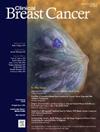基于人工智能的乳腺癌有丝分裂自动评分提高了观察者之间的一致性和效率。
IF 2.5
3区 医学
Q2 ONCOLOGY
引用次数: 0
摘要
背景:评估有丝分裂活性对乳腺癌治疗至关重要;然而,人工评分是不精确的,有相当大的观察者之间的差异,但综合图像分析可以解决这个问题。我们设计了一个基于人工智能的工作流程,用于乳腺癌图像的有丝分裂自动评分。材料与方法:纳入93例患者117张整片图像,使用97张图像训练有丝分裂检测模型。第一个数据集的注释采用磷酸化组蛋白- h3免疫组化抑制指导,构建辅助标记模型。第二个数据集被扩展到包括交互式学习。自动评分框架包括图像分割、上皮区域分割、有丝分裂检测、热点分析和评分分类。临床应用由3名病理学家使用20张幻灯片图像进行评估。结果:有丝分裂模型的f1评分为0.75,与其他先进算法相当。自动评分工作流程通过彻底分析整个幻灯片来定位热点,提高了病理间的一致性,但略微低估了有丝分裂评分。阅读时间由平均452 s显著缩短至52 s (P < 0.01)。结论:本研究表明,集成有丝分裂自动评分系统可以促进病理最终用户高效实现更高的一致性,为精准医疗提供坚实的基础。在数字病理学时代,评估有丝分裂活动的新方法是必不可少的。本文章由计算机程序翻译,如有差异,请以英文原文为准。
Artificial Intelligence-Based Automatic Mitosis Scoring in Breast Cancer Improves Inter-Observer Concordance and Efficiency
Background
Evaluation of mitotic activity is crucial for breast cancer treatment; however, manual scoring is imprecise, with considerable inter-observer variation, but comprehensive image analysis may address this problem. We designed an artificial intelligence-based workflow for automatic mitosis scoring of breast cancer images.
Materials and Methods
Ninety-three cases, including 117 whole-slide images, were enrolled and 97 images were used to train the mitosis detection model. The annotation of the first dataset was guided by phosphohistone-H3 immunohistochemical restraining to build an auxiliary label model. The second dataset was expanded to include interactive learning. The automatic scoring framework included image partitioning, epithelial area segmentation, mitosis detection, hotspot analysis, and score classification. Clinical utility was evaluated by 3 pathologists using 20 slide images.
Results
The mitosis model achieved an F1-score of 0.75, which is comparable to that of other state-of-the-art algorithms. The automatic scoring workflow located hotspots by thoroughly analyzing the entire slide, which improved inter-pathologist concordance, but slightly underestimated the mitosis score. In addition, the reading time decreased significantly from an average of 452 s to 52 s for each case (P < .01).
Conclusion
This study demonstrated that an integrated automatic mitosis scoring system could boost pathology end users to efficiently achieve higher concordance, providing a solid foundation for precision medicine. Novel methodologies are essential in assessing mitotic activity in the era of digital pathology.
求助全文
通过发布文献求助,成功后即可免费获取论文全文。
去求助
来源期刊

Clinical breast cancer
医学-肿瘤学
CiteScore
5.40
自引率
3.20%
发文量
174
审稿时长
48 days
期刊介绍:
Clinical Breast Cancer is a peer-reviewed bimonthly journal that publishes original articles describing various aspects of clinical and translational research of breast cancer. Clinical Breast Cancer is devoted to articles on detection, diagnosis, prevention, and treatment of breast cancer. The main emphasis is on recent scientific developments in all areas related to breast cancer. Specific areas of interest include clinical research reports from various therapeutic modalities, cancer genetics, drug sensitivity and resistance, novel imaging, tumor genomics, biomarkers, and chemoprevention strategies.
 求助内容:
求助内容: 应助结果提醒方式:
应助结果提醒方式:


